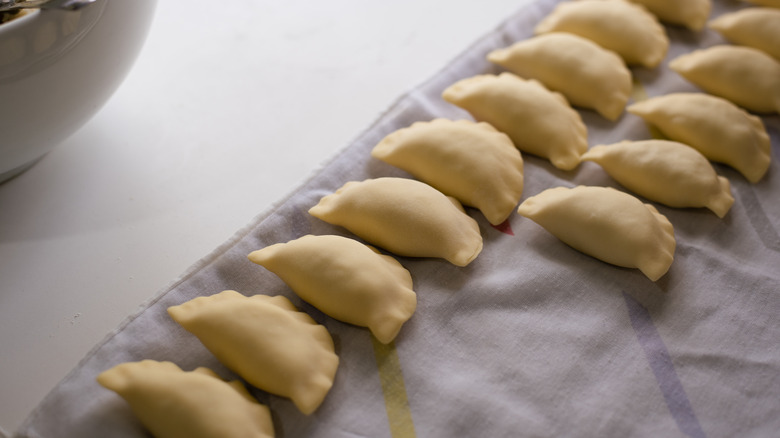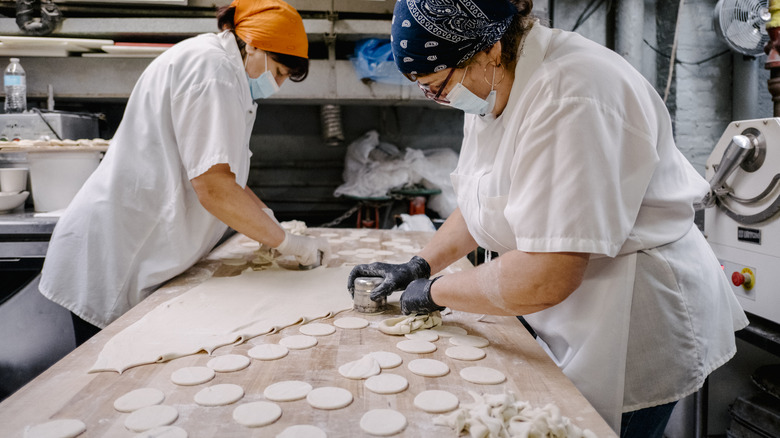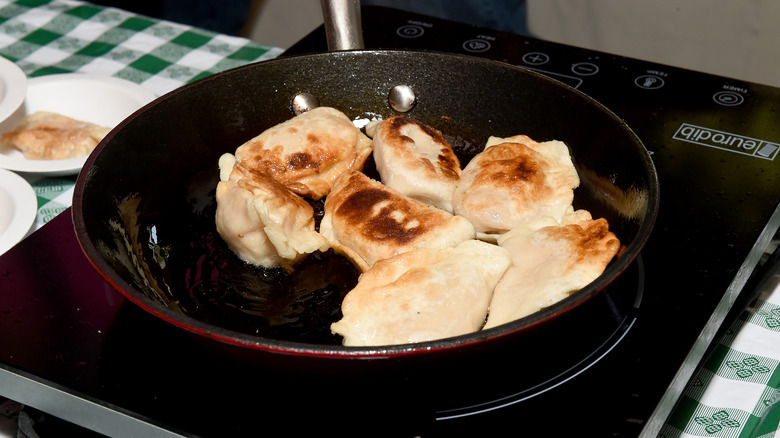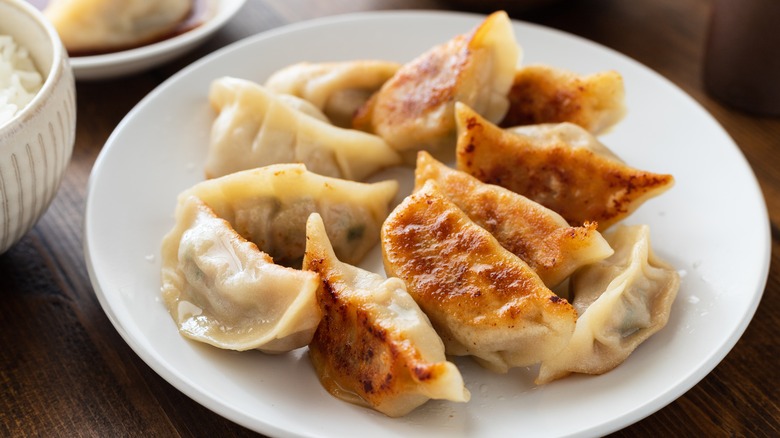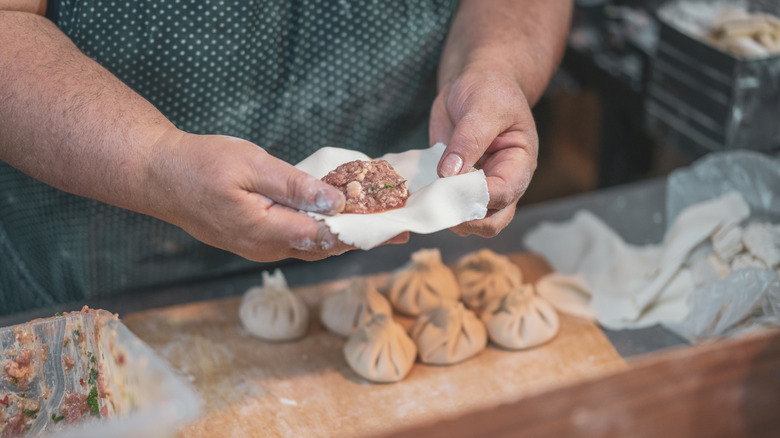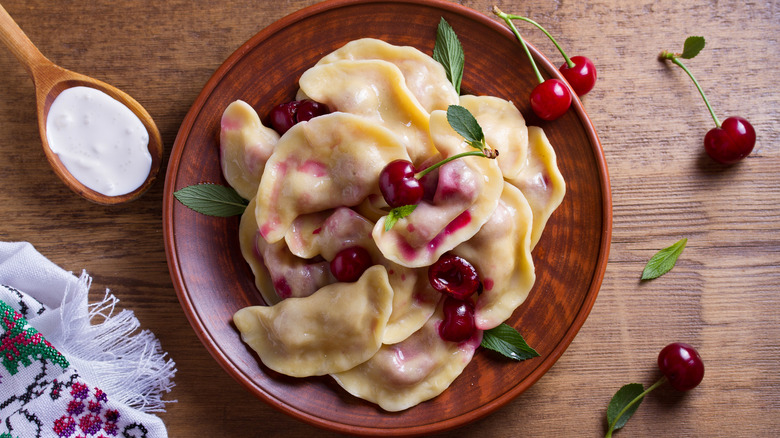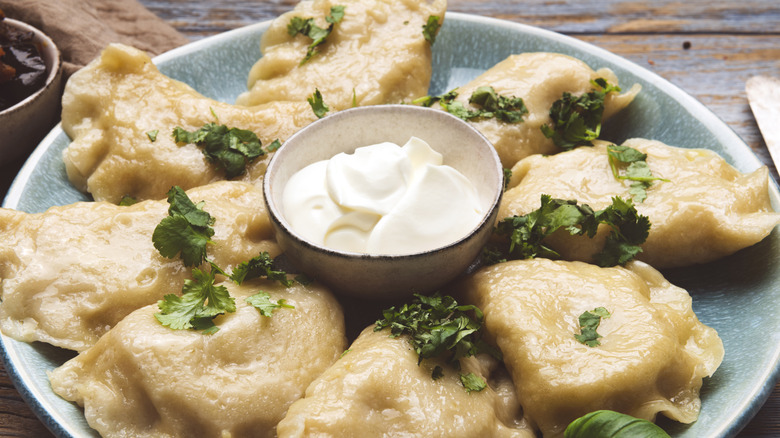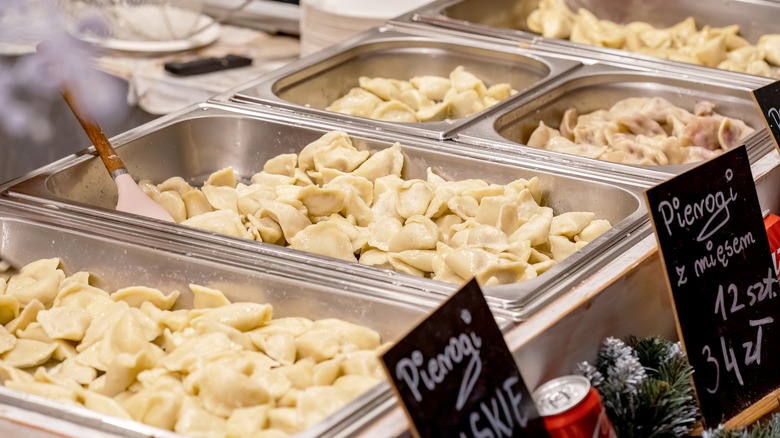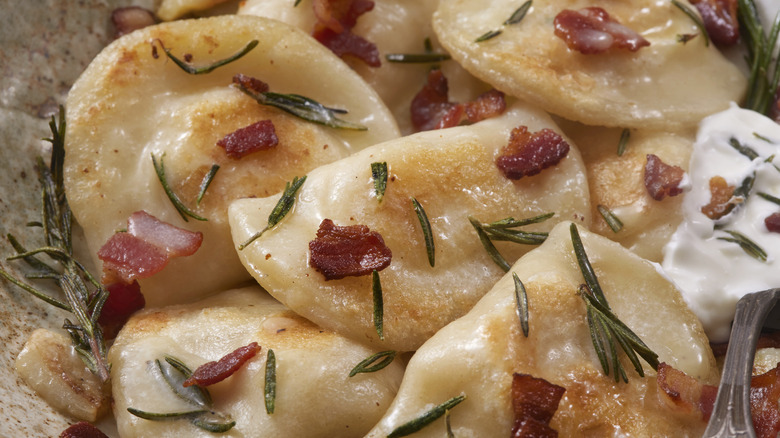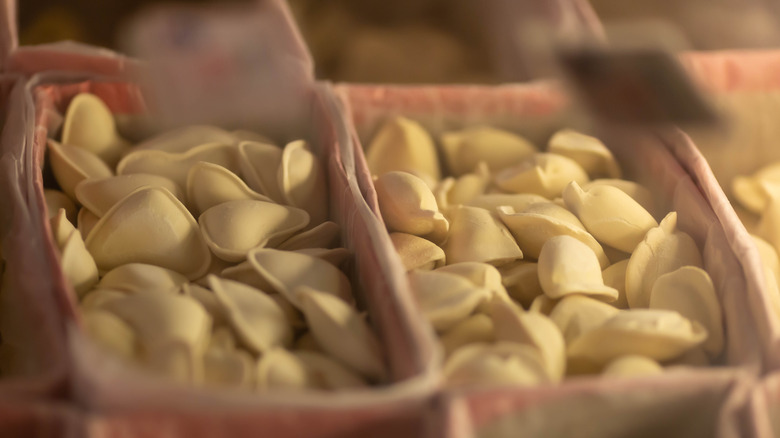What Are Pierogi And What Should You Use As A Filling?
Pierogi have been a part of Polish cuisine for centuries; these moreish dumplings were even featured in the nation's first-ever cookbook. It's not surprising that, over time, pierogi have become a central part of not only Polish cuisine but the country's cultural identity, as chef Sandra Kotowicz highlighted to the BBC saying, "When you think about this dish, you think about home, about traditional, about your grandmother." While often pluralized as "pierogies" in English, most people from Poland will point out that the word "pierogi" is already plural. After all, nobody eats only one.
It's not only Poland that appreciates pierogi. The dumplings are popular across the United States, especially in urban centers with significant Eastern European populations like Pittsburgh. In fact, pierogi are so well-liked in north-eastern America that the area was nicknamed the Pierogi Pocket by leading pierogi manufacturer Mrs. T's.
For Americans living outside the Pierogi Pocket, pierogi can be something of an unknown. These diners may wonder how pierogi are different from the plethora of other Eastern European dumplings. They are also likely unaware of the many ingredients that are traditionally used to stuff them. In this article, we aim to help these people by answering some key questions about pierogi. What's more, we'll also give a few recommendations on where to both buy and enjoy pierogi in the U.S. to ensure that your next pierogi experience, whether it's your first or your thousandth, is one to remember.
What are pierogi?
Pierogi are a type of dumpling that's made from unleavened dough and stuffed with various fillings, either savory or sweet. Although most widely known as a Polish food, very similar filled dumplings are also eaten in several other Eastern European countries, including Ukraine where they're known as varenyky. These dumplings are hypothesized to have originated in the Middle East. Professor of anthropology Eugene Anderson highlighted this to the South China Morning Post, saying, "It certainly seems more and more clear that these stuffed dumplings were invented in the Middle East somewhere, and then picked up and spread everywhere by the Turkic but also by Iranic people and others."
Once stuffed dumplings made it to Poland, they were adopted by both wealthy and regular citizens. The latter group used cheaper, more readily available ingredients as fillings, and many of these, like cheese and potato, have come to define traditional, Polish pierogi.
Pierogi are extremely time-consuming to make from scratch. As a result, the dumplings became associated with celebratory occasions like Christmas Eve. The advent of mechanized food production, plus the rise of specialist restaurants known as pierogarnia, has meant pierogi can now be eaten year-round. Yet, the dish has retained its cultural importance with many people viewing it as the quintessential Polish food.
How are pierogi made?
The first step in making pierogi is forming the dough. This is usually made by combining flour, salt, water, and oil although other ingredients like egg yolks or sour cream are often used in an effort to make the dough richer. The dough is then kneaded until fully combined. As an unleavened dough, it doesn't require proving, but it does benefit from resting as this allows the gluten to relax.
Once rested, the dough is rolled into a sheet that's around one-eighth of an inch thick before being cut into circles. A spoonful of the chosen filling is placed on each of these discs, which are then folded over to cover the filling and create a pleasant half-moon shape. Pinching the dough together creates a seal that prevents the pierogi from splitting during cooking. The seal can be strengthened by twisting the excess dough, creating a tightly rolled edge. After sealing, the pierogi are ready to be cooked.
How to cook pierogi
As with many types of dumpling, pierogi can be cooked in several different ways. The most common is boiling, as this technique can be used for both fresh and frozen pierogi. All people have to do is place the pierogi in boiling water and wait, and they'll float when fully cooked. As with pasta, it's important to adequately salt the water when cooking pierogi lest they be under-seasoned. Overcooking should also be avoided — if left to boil for too long the pierogi will burst.
Another popular means of cooking pierogi is sautéing. Traditionally, the dumplings are sautéed with butter until the dough browns. This technique is best used with store-bought pre-boiled pierogi or ones that you have previously boiled yourself; boiling beforehand ensures the filling and dough are both completely cooked through and prevents any risk of undercooked dough or filling being served. It's important not to crowd the pan when sautéing pierogi and to flip them regularly to ensure browning occurs in an even manner.
Other cooking methods also abound including steaming, baking, deep-frying, and grilling. All of these techniques have their own positives and negatives. However, we find there's not much reason to deviate from the traditional practice of boiling and then sautéing.
Pierogi vs potstickers
Thanks to their similarities, pierogi are often confused with other dumplings including Chinese potstickers which are otherwise known as jiaozi. Both types of dumplings are served at celebrations and both can be filled with a variety of ingredients. However, the two dumplings do vary in several ways.
While some sort of fat is usually incorporated into pierogi dough — usually eggs, butter, or oil — no fat is present in the dough that's used to make potstickers. Instead, the dough is made from a simple mixture of flour and boiling water. What's more, potsticker dough is rolled much thinner than pierogi dough. This gives potstickers a translucent appearance when cooked. The means by which the two dumplings are cooked also differ. As their name suggests, potstickers are usually fried on one side which 'sticks' to the pan. The dumplings are then steamed. This process lends them an interesting textural contrast with a crisp underside and a soft upper half. Pierogi, on the other hand, are usually boiled and then sautéed. In this manner, they brown all over.
Finally, the accompaniments served alongside potstickers and pierogi differ. The former usually comes with a dipping sauce made from soy sauce, ginger, and garlic, whereas pierogi are traditionally served alongside sour cream.
Do pierogi differ from other Eastern European dumplings?
It's not just Chinese dumplings that get confused with pierogi but dumplings from Eastern European countries too. Many of these hail from neighboring countries and share many characteristics with Poland's pierogi.
The dumplings that are most often confused with pierogi are pelmeni. Pelmeni come from Russia and, similarly to pierogi, are made with unleavened dough. However, pelmeni fillings are not pre-cooked and nearly always include meat. This is in contrast to pierogi which often boast pre-cooked, vegetarian fillings. Sweet pierogi are also common during the summer months whereas sweet pelmeni are not. Furthermore, the unleavened dough used to make pelmeni is rolled thinner than it is for pierogi and, when served, the Russian dumplings are usually topped with black pepper and dipped in vinegar.
Piroshky (sometimes spelled pirozhki), another type of Russian dumpling, is sometimes conflated with pierogi thanks to their similar names. However, when the two dumplings are placed beside one another their differences are readily apparent. This is because piroshky are made with a leavened dough that rises during baking. The result is a more bread-like dumpling that's lighter and larger than pierogi.
What fillings are used in pierogi?
Over the centuries, many fillings have been used to stuff pierogi. In the 17th and 18th centuries, pierogi — like a lot of food at the time — were a means of expressing class and wealth. For this reason, some early pierogi were stuffed with fruit and expensive spices. That being said, the most common pierogi fillings used in the modern day are more modest as exemplified by pierogi ruskie. This popular type of pierogi is filled with a mixture of twaróg, onions, and mashed potatoes. Twaróg is a traditional Polish cheese that gives the pierogi ruskie a creamy, slightly sour flavor.
During the autumn and winter months, pierogi are stuffed with a mixture of wild mushrooms and sauerkraut. These pierogi are traditionally eaten on Christmas Eve as many Polish people do not eat meat on this day for religious reasons. The dumplings are served in bowls of borscht.
Summer is the season when most sweet pierogi are made. These are usually stuffed with sweet cheese and any number of fruits including bilberries, strawberries, and cherries. The one exception to this is poppy seed pierogi. These are served during Christmastime and are filled with a sweet mixture of poppy seeds, dried fruit, and ground walnuts.
How are pierogi served?
Pierogi are perfect for dipping. For this reason, they are often served alongside any number of sauces and accompaniments. Sour cream is the most traditional of these and it pairs perfectly with the cheese-rich filling of pierogi ruskie. The sour cream is usually bolstered by an array of toppings as one Polish citizen highlighted on Reddit, saying "as long as the filling is savory (meat, sauerkraut, shrooms, potato and cheese), you can't go wrong [with] caramelized onions, little bacon bits and sour cream on the side for dipping." Other popular toppings for savory pierogi include slices of kielbasa (smoked sausage) and an array of finely chopped herbs.
Melted butter is used as a simple yet effective sauce for all kinds of pierogi, even sweet ones which are often served with clarified butter. Sweet pierogi are usually also topped with spices like cinnamon and fresh fruit and berries. Powdered sugar is also sprinkled liberally over these pierogi.
Where to buy pierogi?
America's large Eastern European population, together with the growing popularity of pierogi globally, means it has never been easier for Americans to buy pre-made pierogi. Generally speaking, there are two options: Buy pierogi from specialist shops and Polish delis or buy mass-produced products from international grocery store brands.
The former option is much easier for those living in the aforementioned Pierogi Pocket. There are many stores abound in this area, selling both fresh and frozen pierogi. For those living outside this area or unable to shop in person, the best bet is to purchase mail-order pierogi from reputable companies like Piast Meat & Provisions. This company ships its excellent pierogi to all 50 states from its base in New Jersey. Please note, however, pierogi are only available as part of the company's larger bundles.
For those who don't want to wait for shipping, pierogi can be picked up from many major grocery stores including Lidl. This company stocks the popular Mrs. T's brand of frozen pierogi which make for a quick and easy meal. Although these products are widely celebrated for their quality and low price, they lack the flavor or tradition of those made by Polish food businesses, and experts say that frozen pierogi are never as good as fresh.
Nutritional information about pierogi
The nutritional profile of pierogi depends largely on what filling they contain. Those loaded with meat and cheese will invariably hold more fat than vegetarian pierogi filled with the likes of mushrooms and sauerkraut. That being said, a single pierogi ruskie is thought to contain only one or two grams of fat. If sides like sour cream are enjoyed, though, this amount will greatly increase.
Who produces the pierogi also influences the dish's nutritional value. Mrs. T's frozen pierogi, for example, are known to contain a lot of salt — four of these pre-made pierogi contain nearly a quarter of an adult's daily recommended sodium intake. Those made in a non-industrial setting will likely contain much less salt.
Pierogi are known as a great source of carbohydrates thanks to the flour-rich dough and the fact that potatoes are often used as a filling. What fewer people are aware of is that home cooks can easily boost the amount of fiber in the pierogi by substituting a proportion of all-purpose flour for a whole-grain alternative. Doing so will make the product markedly healthier.
Where can you eat the best pierogi in the U.S.?
The best pierogi-serving restaurants in the United States are found in the country's urban centers, especially those with large Polish populations. Being one such place, New York City is home to several exceptional pierogi restaurants, and Pierozek is among the best-known of them. Opened in November 2019, Pierozek has made a name for itself thanks to traditional recreations of classic Polish pierogi. The owners invited chefs from PierozeQ, a pierogi restaurant in Czestochowa, Poland, to help educate them when the restaurant initially opened. Speaking to The Michelin Guide, they explained, "We worked hard so that [diners] taste that authentic, original recipe. The truest, most authentic, simple dishes you grow up eating in Poland." Baba's Pierogi in Brooklyn is another notable establishment in New York City with a contrasting philosophy. Here innovation is served alongside tradition, with some slightly leftfield pierogi fillings like mac and cheese.
Pittsburgh is a city that's also known for its abundance of pierogi-serving establishments and S&D Polish Deli is among the best. As one TripAdvisor review mentions, "I had the potato and farmer's cheese, and my husband had the meat, and we traded bites to be able to sample both. They were splendid and oh-so-tasty! The fillings were delicious, and the pasta wraps were outstanding."
How to store pierogi
Because they're so time-consuming to make, most people produce pierogi in bulk and save the remainder for a later date. The dumplings are well-suited to this approach, as they can be kept in the fridge for two to three days if uncooked or up to a week if pre-cooked. Pierogi left in the fridge only need to be placed on a tray and covered with plastic wrap.
Stored in the freezer, pierogi can last for 4-6 months. When freezing pierogi it's recommended to blanch them in boiling water prior to placing them in the freezer, as this will prevent the dough from cracking. They should also be well-spaced lest they stick together.
Despite there being several ways to store pierogi, purists claim that they are best enjoyed fresh. Chef Sandra Kotowicz highlighted this point specifically in an interview with the BBC, when she mentioned, "The perfect one[s] are always fresh. You cannot boil it before; you cannot freeze them; you cannot reheat them; you cannot marinate them with the oil to keep them fresh longer."

